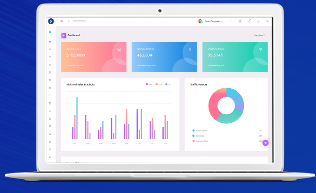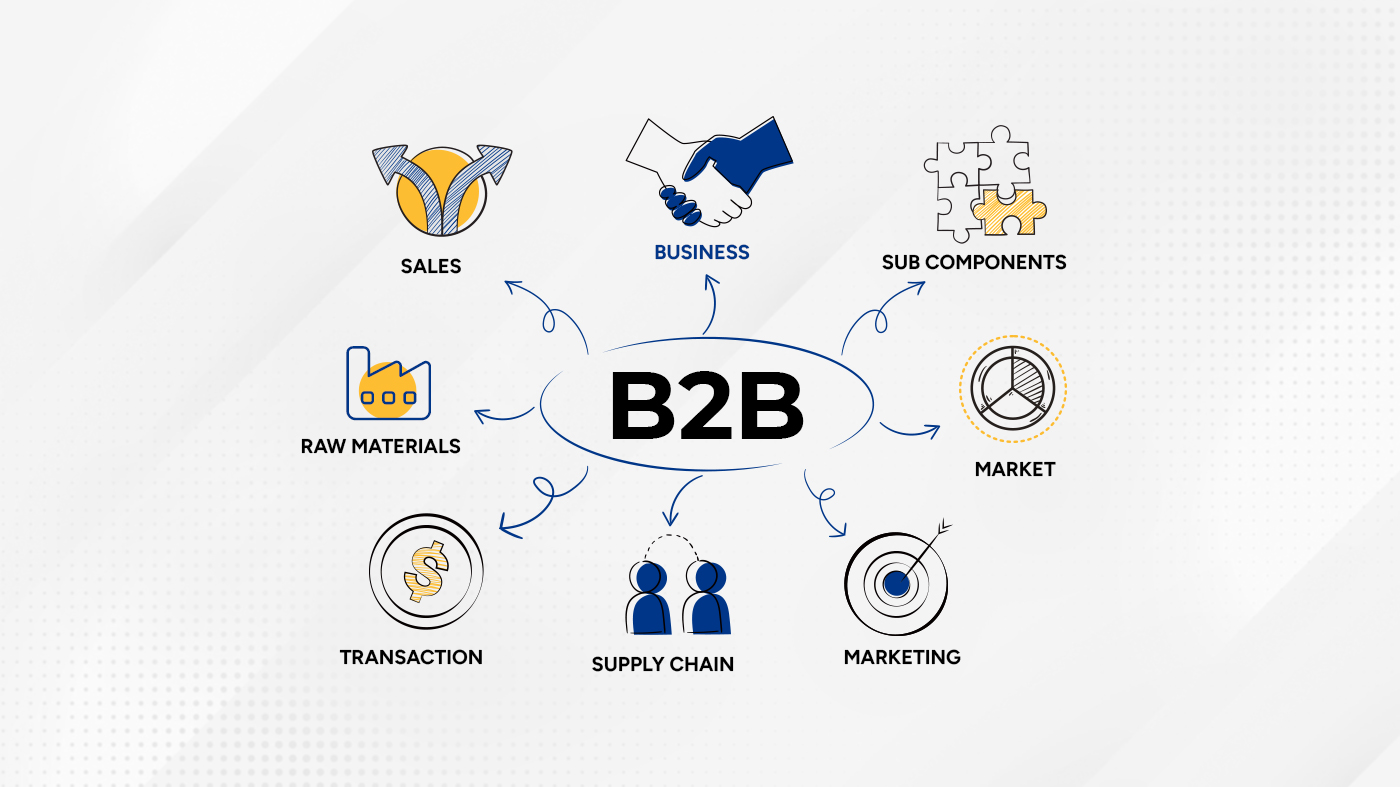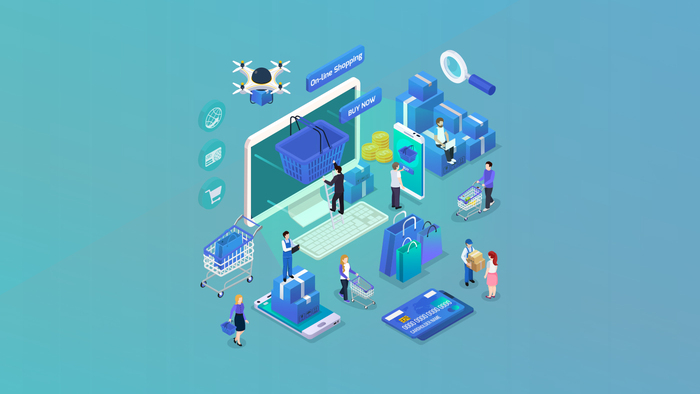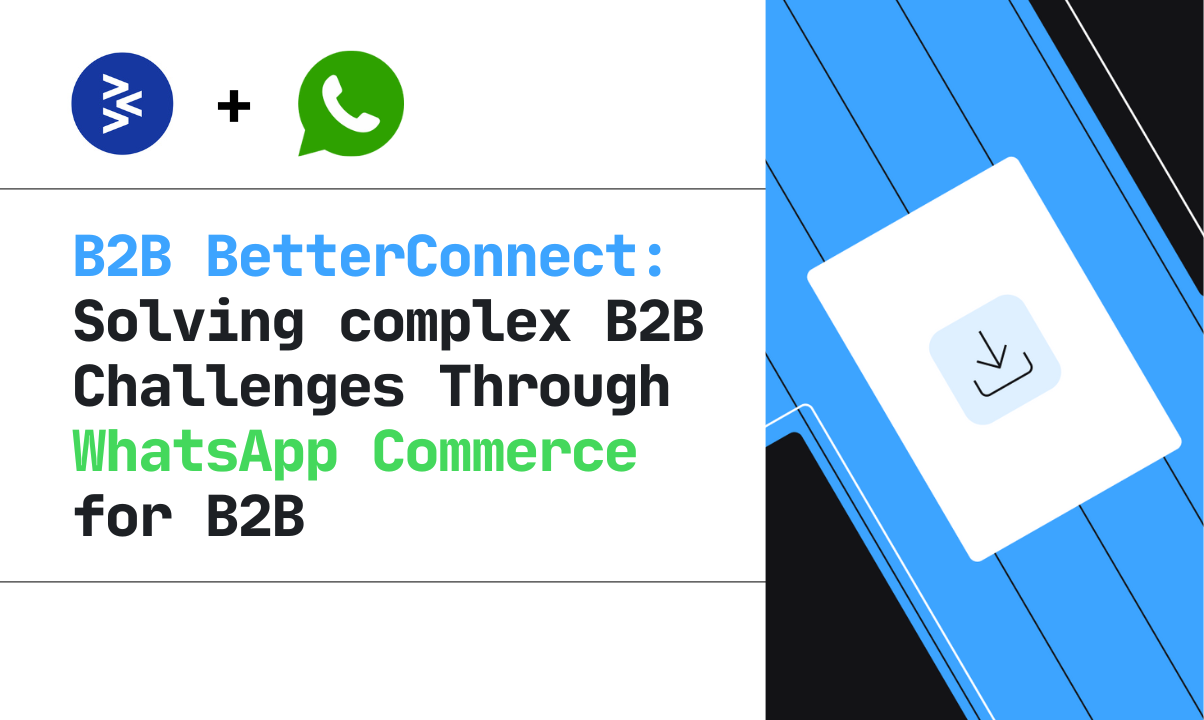Ready to drive in?
Schedule a demo
In the current commerce market, customers are hungry about the product information when making buying decisions. Thus, it becomes important to provide a better and accurate product information to your customers.


09-August-2024

39 min read
Table Of Contents
Section 1: Introduction
- Importance of Technology in Modern B2B Ecosystems
Section 2: Understanding B2B Commerce
- Distinctions between B2B and B2C Commerce
- Key Characteristics of B2B Markets
Section 3: The Evolution of B2B Commerce Technology
- Historical Overview of B2B Commerce Technologies
- Transition from Traditional Methods to Digital Platforms
- The Impact of Digital Transformation in the B2B Landscape
- B2B Channels
Section 4: Core Technologies to Build a B2B Commerce Platform
- OMS
- PIM
- Supply Chain Management (SCM) Systems
Section 5: The Rise of Commerce Platforms in B2B
- Features Specific to B2B Commerce Platforms
- Comparison of Leading B2B Commerce Platforms
- Case Studies of Successful B2B Commerce Implementations
Section 6: Advanced Technologies Shaping B2B Commerce
- Artificial Intelligence & Machine Learning
- Predictive Analytics in Customer Purchasing Behaviour
- AI in Customer Service & Support
- Blockchain for B2B Transactions
- Smart Contracts in B2B Agreements
Section 7: Challenges & Solutions in B2B Commerce Technology
- Addressing Integration Complexities
- Ensuring Data Security and Privacy
- Overcoming Resistance to Digital Adoption
- Strategies for Continuous Technology Updating and Training
Section 8: Future Trends in B2B Commerce Technology
- Predictive Insights for Better Strategic Planning
- Increased Automation and Its Impacts
- Role of 5G and Enhanced Connectivity Solutions
Section 9: Implementing a Successful B2B Commerce Strategy
- Steps for Choosing the Right B2B Commerce Platform
- When Should I opt for Commerce?
- Key Performance Indicators (KPIs) for Measuring Success
Section 10:
- Conclusion
Section 1: Introduction
B2B commerce is all about selling and marketing products online between businesses. The mission? To broaden your customer base and cut down on costs, boosting your revenue.
B2B commerce, simply put, is any business conducted online between two companies. From supplying equipment to essential services like manufacturing or distribution, businesses thrive on these interactions. With the shift to online platforms, B2B transactions have followed suit.
According to the US Department of Commerce's International Trade Administration, global B2B commerce is projected to hit a staggering $36 trillion by 2026, with a 14.5% annual growth rate over the next decade.
Ready to dive into a $36 trillion industry? Adapt to B2B commerce and you are good to go! Dive into our comprehensive guide to learn everything about B2B commerce and stay updated with the latest trends.
Importance of Technology in Modern B2B Ecosystems
Technology is the secret sauce in today’s B2B ecosystems, whipping up efficiency, scalability, and a generous dash of innovation. In the cutthroat world of commerce, staying ahead means embracing the latest tech. Think of commerce platforms, PIM systems, and SCM solutions as your business’ ultimate dream team.
In this cutthroat world of commerce, staying ahead means embracing the latest technology. In the B2B world, technology and trends like PIM systems, omnichannel integration, backend integration with ERPs, order management systems, and supply chain management solutions work as your online powerhouse equipped with all the bells and whistles you need to manage your digital storefront.
A whopping 83% of companies surveyed are gearing up to boost their digital investments in 2024, planning to spend more than they did last year. Can technology integrations lead to customisable catalogues, integrated payment gateways, and smart analytics? Check, check, and check!
By harnessing tech marvels, you’ll streamline operations, cut costs, and wow your customers. Plus, the insights and analytics they provide will help you become a data-driven decision-maker. Embracing technology in the B2B world isn’t just smart—it’s essential for staying competitive and achieving long-term success.
Section 2: Understanding B2B Commerce
- Distinctions between B2B and B2C Commerce
B2B (business-to-business) and B2C (business-to-consumer) might sound similar, but they’re as different as night and day. Understand it better, here:
- Customer Base: B2C targets individual consumers, focusing on personal preferences and needs. In contrast, B2B commerce caters to other businesses, which have specific and often more complex purchasing requirements.
- Buying Behaviour: The buying process in B2C is relatively straightforward and quick, driven by personal preferences and impulsive decisions. B2B purchasing involves thorough research, multiple touchpoints, and longer sales cycles due to the higher stakes and larger investments.
- Key Characteristics of B2B Markets
- Longer Sales Cycles: Unlike the quick, often spontaneous purchases in B2C, B2B transactions are characterised by their extended sales cycle, or one can say that they take their sweet time! B2B sales involve multiple stages, like research, evaluation, and negotiations. Why? Because B2B transactions pass through several stakeholders within the purchasing company.
- Complex Decision-Making Processes: Coming down to decision-making, which we must say, is not a one-person show. It typically involves multiple departments, meaning that a single purchase might need a thumbs-up from procurement, finance, and the end-user department. This multifaceted process ensures that the purchase meets the operational, financial and strategic goals of the business.
- Larger Transaction Volumes: B2B transactions often mean bulk orders and big bucks! Businesses buy in large quantities, whether it’s raw materials for manufacturing or massive software licenses for enterprise use. These hefty transactions require more rigorous approval processes and negotiations. In B2B business, it’s not merely shopping, it’s all about being strategic.
By understanding these distinctions and characteristics, businesses can better tailor their strategies to succeed in the B2B market. Effective B2B commerce requires not only a deep understanding of these dynamics but also the ability to manage complex relationships and transactions efficiently.
Section 3: The Evolution of B2B Commerce Technology
- Historical Overview of B2B Commerce Technologies
A staggering 90% of B2B buyers would turn to a competitor if a supplier’s digital channel couldn’t meet their needs. This statistic underscores the critical importance of B2B retailers embracing technology and its advantages. But how did this trend come about?
Initially, B2B transactions were conducted through traditional methods such as phone calls, faxes, and face-to-face meetings. These manual processes were time-consuming and often prone to errors, limiting the scalability and efficiency of business operations.
- Transition from Traditional Methods to Digital Platforms
Then, bam! The internet swooped in wearing a superhero cape. The advent of the internet marked a significant turning point for B2B commerce, ushering in an era of digital transformation. Businesses embraced digital platforms that automated critical processes such as order and inventory management. This shift enabled businesses to operate more efficiently, reduce overhead costs, and improve accuracy in transactions.
Moreover, digital transformation in B2B commerce paved the way for enhanced customer experiences and greater scalability. Businesses could now offer personalised services, streamline communication, and provide real-time updates to their clients. The integration of advanced analytics allowed companies to gain deeper insights into customer behaviours and market trends, empowering them to make data-driven decisions and stay ahead of the competition.
The result? Let’s talk about that in the next section.
At least 40% of all businesses will die in the next 10 years… if they don’t figure out how to change their entire company to accommodate new technologies.
- John Chambers | Cisco
- The Impact of Digital Transformation on the B2B Landscape
Digital transformation has revolutionised the B2B landscape by enhancing operational efficiency across the board. It’s not just about doing things faster; it’s about doing them smarter. Artificial intelligence (AI) and machine learning (ML) became favourites, predicting what customers want, tweaking prices just right and even chatting up customers like a pro.
Why should your business embrace digital transformation?
Going digital provided and will continue to provide businesses with unprecedented capabilities.
- B2B Channels
1. Commerce Platforms
Commerce platforms are like virtual malls for businesses. It basically means setting up your own shop online, where you get to flaunt everything you’ve got—be it a high-tech gadget or industrial machinery. Customers stroll through, comparing options, and when they find what they need, they make the purchase directly through these platforms, which are tailored to handle B2B needs like bulk ordering and detailed product specifications. The global B2B commerce market size is expected to reach $18,771.4 billion by 2027.
2. Mobile Apps
Think of these as B2B’s pocket-sized assistants. These apps are designed for smartphones and tablets, offering easy access to catalogues, ordering systems, and even real-time customer support. They bring the convenience of commerce straight to your fingertips. 83% of salespeople say that having access to mobile sales tools makes their company appear more cutting-edge than their rivals, which in turn makes them more attractive to customers.
3. EDI (Electronic Data Interchange)
This one’s the OG of digital transactions. EDI can speed up your business cycles by as much as 61%. EDI allows businesses to exchange documents—like invoices, purchase orders, and shipping notices—in a standardised electronic format. It’s secure, efficient, and cuts down on paperwork.
4. Online Marketplaces
Online marketplaces are bustling hubs where multiple sellers and buyers converge. They streamline B2B transactions by offering a wide range of products, plus handy services like logistics and payment processing. Platforms like these make it easy to shop around and strike deals. The B2B online marketplace sector is expected to grow at a compound annual growth rate (CAGR) of over 25%.
Examples of popular B2B online marketplaces include Alibaba, which connects millions of buyers and suppliers globally, and Amazon Business, a platform tailored for businesses to purchase in bulk with exclusive business-only pricing. Another notable example is ThomasNet, a directory and sourcing platform for industrial and manufacturing products.
5. Social Media
No longer just for selfies and status updates, social media platforms are now hotspots for B2B networking. They’re great for building relationships, generating leads, and engaging with customers through targeted content and direct messaging. 78% of B2B marketing companies consider LinkedIn to be the most powerful social media platform for their type of content.
6. Direct Sales
Old-school but still effective. Direct sales involve face-to-face meetings, sales teams armed with catalogues, and good old-fashioned negotiation. It’s personal, hands-on, and perfect for sealing those big deals. 91% of B2B sales professionals engage in upselling, contributing an average of 21% of company revenue.
7. Partner Portals
These secure online platforms are like VIP lounges for business partnerships. They’re where companies collaborate, manage accounts, and coordinate joint activities—all in a private, controlled environment. Partner portals can improve collaboration by up to 67% among partners.
8. Subscription Services
B2B isn’t just about one-time purchases anymore. Subscription services offer businesses the convenience of regular deliveries or access to software and services on a recurring basis. It’s predictable, scalable, and managed seamlessly through online platforms. Subscription-based companies typically have 90% higher customer retention rates compared to traditional businesses.
These channels are versatile, catering to different industries, regions, and specific business needs. They’re the digital toolkit that keeps B2B transactions running smoothly in today’s fast-paced business world.
Section 4: Core Technologies to Build a B2B Commerce Platform
- OMS
Having an Order Management System (OMS) is like having an ultimate multitasker in your B2B Commerce operations. It seamlessly integrates and automates critical order processing workflows. Think of them as your behind-the-scenes maestro, ensuring that every order is processed flawlessly and on time. This real-time insight ensures accurate and timely order fulfilment, eliminates manual processes reducing order errors by 62% crucial for maintaining a high level of customer satisfaction and operational efficiency.
Integrated with ERP (Enterprise Resource Planning) and CRM (Customer Relationship Management) systems, OMS not only facilitates efficient order fulfilment but also empowers businesses to make informed, data-driven decisions in real-time.
Technologies such as cloud computing, artificial intelligence (AI), and machine learning (ML) play a pivotal role in enhancing the capabilities of OMS:
• Cloud computing provides the scalability and flexibility needed to handle large volumes of orders and data, ensuring that businesses can easily expand their operations without significant infrastructure investment.
• AI and ML enable predictive analytics and intelligent automation, allowing the system to forecast demand, optimise inventory levels, and automatically route orders to the most efficient fulfilment centres.
• Additionally, integration with Internet of Things (IoT) devices offers real-time tracking and monitoring of shipments, providing greater transparency and control over the supply chain. Together, these technologies ensure that OMS delivers unparalleled efficiency, accuracy, and customer satisfaction.
- PIM
Businesses rely on Product Information Management (PIM) systems to centralise and meticulously manage every detail, ensuring accuracy and consistency across diverse channels. They centralise vast product catalogues, ensuring data integrity across sales teams and distributors. Precision in product specifications is non-negotiable, as PIM systems maintain consistent, high-quality data to mitigate costly errors and build client trust.
PIM systems don’t work alone—they’re the ultimate team players in B2B tech. They integrate with various B2B technologies such as commerce platforms, Order Management Systems (OMS), and Supply Chain Management (SCM) systems. PIM facilitates real-time updates and optimises data presentation for informed decision-making.
This agility extends globally, localising content to meet diverse market needs and enabling swift product expansions. Ultimately, collaborative PIM ensures streamlined workflows and enhances market responsiveness, keeping businesses competitive and adaptive in the dynamic B2B landscape. It’s no wonder that the industry is projected to grow by 25.2% from 2020 to 2027.
| Using a PIM solution reduces errors related to inconsistent or outdated product data, thereby improving operational efficiency. CFOs identify data siloing (69%) and inaccurate data for forecasting and planning (40%) as two of the three biggest mistakes organisations make. |
With unified product information across all channels—whether online storefronts, mobile apps, or offline sales channels—businesses can deliver consistent and personalised customer experiences. This consistency boosts customer satisfaction, and loyalty, and ultimately drives sales growth. In fact, 86% of buyers are willing to pay more for a great customer experience.
Businesses that overlook data accuracy may be driving away 15-20% of their potential revenue.
- Supply Chain Management (SCM) Systems
SCM systems optimise supply chain operations by providing real-time visibility into inventory levels, demand forecasts, and supplier performance. SCM systems use advanced algorithms and data analytics to optimise inventory levels, production schedules, and transportation routes, reducing lead times and costs.
Supply Chain Management (SCM) systems are critical for optimising supply chain operations in B2B commerce. These systems provide real-time visibility into inventory levels, demand forecasts, and supplier performance.
These systems aren't just about crunching numbers; they're about making smart moves that save money and time. By syncing up data from every corner of your supply chain, SCM systems cut costs, ramp up efficiency, and ensure your shelves are never bare when customers come knocking. Businesses with optimised supply chains achieve 15% lower supply chain costs.
SCM systems leverage various advanced technologies to achieve these efficiencies.
- Cloud computing enables real-time data sharing and collaboration, providing scalability and flexibility for managing vast amounts of data.
- Additionally, big data analytics allows for processing and analysing large volumes of data to identify patterns and insights that inform strategic decisions.
- Blockchain technology ensures secure and transparent transactions, enhancing trust and traceability throughout the supply chain.
These technologies collectively enable SCM systems to reduce costs, improve efficiency, and maintain optimal inventory levels, ultimately enhancing overall supply chain performance.
Section 5: The Rise of Commerce Platforms in B2B
- Features Specific to B2B Commerce Platforms
B2B commerce platforms cater specifically to the needs of businesses engaged in wholesale, distribution, and other B2B transactions. Here’s a rundown of crucial B2B capabilities and their importance across various types of B2B businesses.
Capability: This feature allows businesses to manage user accounts, including role-based access, permissions, and account hierarchies.
Use Case: B2B businesses often have multiple users with different roles and permissions. For instance, a manufacturer might need to manage accounts for sales representatives, procurement managers, and finance teams, each requiring different access levels. Proper user account management ensures that relevant information and functionalities are accessible to appropriate users, streamlining operations and enhancing security.
Capability: This includes the ability to create, organise, and manage product catalogues with detailed specifications.
Use Case: Distributors and wholesalers deal with extensive product lines and need to present products with complex specifications. A robust catalogue management system helps in maintaining accurate, up-to-date information and simplifies the search and selection process for buyers. For example, a wholesaler needs to manage multiple product categories and variations, which requires a flexible and comprehensive catalogue system.
Capability: Includes features for dynamic pricing, customer-specific pricing, volume discounts, and promotional pricing.
Use Case: Manufacturers and distributors often deal with negotiated pricing and bulk discounts. Dynamic pricing tools enable businesses to adjust prices based on various factors like order volume, customer agreements, or market conditions. This flexibility is crucial for maintaining competitive advantage and fostering strong customer relationships.
Capability: This encompasses the end-to-end management of order processing, from placement to fulfilment and invoicing.
Use Case: Efficient order processing is vital for all B2B operations. For instance, a distributor needs to manage large order volumes, track order status, and ensure timely fulfilment. Advanced order management systems help minimise errors, reduce processing times, and improve customer satisfaction.
Capability: The ability to integrate with other systems like ERP, CRM, and accounting software.
Use Case: Integration with existing systems is crucial for seamless operations. For example, a manufacturer might need to integrate its commerce platform with its ERP system to synchronize inventory levels, manage production schedules, and streamline financial processes. This ensures data consistency and operational efficiency.
Capability: Tools that support sales representatives in the field, such as mobile access to customer data, order placement, and real-time updates.
Use Case: Field sales teams require access to real-time information and the ability to place orders on the go. For example, a wholesaler’s sales reps might need to check product availability, place orders, or update customer information while visiting clients, which necessitates mobile-friendly and integrated field sales tools.
Capability: Features for creating, managing, and tracking quotes and proposals.
Use Case: In B2B transactions, quotes often involve negotiations and approvals. Manufacturers and distributors need tools to generate detailed quotes, track their status, and manage revisions. This capability helps streamline the quoting process and ensures accurate pricing and terms.
Capability: Advanced search functionalities that allow users to find products quickly using various filters and search criteria.
Use Case: With extensive product catalogues, effective site search is crucial. For instance, a distributor with a vast inventory needs a robust search engine to help buyers find specific products quickly, reducing frustration and improving the overall user experience.
- Comparison of Leading B2B Commerce Platforms
Several platforms are prominent in the B2B Commerce landscape, each offering unique strengths:
- BetterCommerce
BetterCommerce stands out with its comprehensive suite of tools designed to manage complex product catalogues, customise pricing strategies, and seamlessly integrate with enterprise systems. It excels in advanced Product Information Management (PIM) capabilities, ensuring accuracy and consistency across all channels.
Additionally, the platform offers streamlined ordering processes, personalised pricing and payment options, robust catalogue management, and advanced analytics and reporting tools.
BetterCommerce commerce suite’s scalability and flexibility make it suitable for mid-sized to enterprise businesses aiming to expand operations and enhance customer experiences through omnichannel strategies.
- Kibo Commerce
Kibo Commerce is recognised for its comprehensive B2B digital commerce capabilities. Kibo integrates seamlessly with ERP systems and provides a mobile-optimized interface, supporting multi-channel sales to enhance customer satisfaction and operational efficiency
- OroCommerce
OroCommerce excels in offering flexible and powerful tools for managing complex business processes. It supports multiple price lists, personalised catalogues, and RFQ (Request for Quote) processes, enabling businesses to cater to various customer segments effectively.
- Magento
Renowned for its flexibility and scalability, Magento provides robust commerce solutions suitable for various B2B business needs. It offers extensive customisation options, integrations with third-party systems, and support for complex commerce workflows.
- Shopify Plus
Designed to be user-friendly yet powerful, Shopify Plus offers features tailored for B2B commerce, including custom pricing models, bulk ordering capabilities, and integrations with ERP systems. It is particularly favoured for its ease of use and rapid deployment capabilities.
- SAP Hybris
SAP Hybris provides an integrated commerce solution with advanced features for managing large-scale B2B transactions. It offers robust capabilities for order management, customer service, and personalised marketing, leveraging SAP's extensive enterprise resources.
- Case Studies of Successful B2B Commerce Implementations
FFX:
Challenge: FFX, a prominent power tools brand, faced issues with inconsistent taxonomy, managing product attributes according to industry standards, and updating product data in bulk. These challenges hindered the customer experience and made product discovery inefficient.
Solution: Implemented a comprehensive Commerce solution using BetterCommerce that included a Product Information Management (PIM) system to streamline product data and reduce SKU counts by 48%. Additionally, a Content Management System (CMS) was utilised to organise and optimise content for the Homepage, Category Pages, and other site sections, enhancing SEO.
Result: Post-re-platforming, FFX experienced a 47% increase in product views and a 23% boost in add-to-cart rates, with overall purchase rates remaining stable. This led to a significant rise in conversions through the revamped website, reflecting improved product information consistency and user experience.
Case Study Coming Soon...
Grainger:
Challenge: Grainger, a leading distributor of industrial supplies, sought to enhance its B2B Commerce capabilities to serve a wide range of customers efficiently.
Solution: Adopted a headless commerce strategy using Oracle Commerce Cloud and Oracle Content Management to deliver personalised and responsive customer experiences.
Results: Streamlined the purchasing process with improved search functionality and tailored product recommendations. The headless approach enabled Grainger to integrate with its existing enterprise systems and adapt quickly to market changes.
Section 6: Advanced Technologies Shaping B2B Commerce
- Artificial Intelligence & Machine Learning
In B2B commerce, AI and machine learning (ML) are indispensable tools for driving efficiency and competitiveness. These technologies dig through mountains of data to find patterns and trends that humans might overlook. For B2B retailers, AI can take the guesswork out of inventory management by predicting demand changes, cutting storage costs, and preventing stockouts. Plus, ML algorithms can also enhance pricing strategies by analysing market dynamics and competitor pricing, allowing retailers to offer competitive prices while maintaining profitability.
By 2030, over 80% of logistics firms are expected to incorporate AI and machine learning into their operations.
- Predictive Analytics in Customer Purchasing Behaviour
70% of B2B retailers report improved sales forecasting accuracy after implementing predictive analytics. AI-powered predictive analytics enable retailers to anticipate customer needs and preferences based on historical data and current trends. By personalising marketing strategies and product recommendations, retailers can increase sales conversions and foster stronger customer relationships. This predictive capability also supports proactive inventory management, ensuring that retailers stock the right products at the right time to meet demand.
But it doesn't stop there. This predictive power also helps with proactive inventory management. It ensures retailers have the right products in stock at the right time to meet demand, avoiding those pesky stockouts and overstock situations. So, not only are you keeping your customers happy, but you're also running a lean, efficient operation.
- Intelligence in Customer Service & Support
74% of people prefer chatbots for resolving common queries because they're more convenient than speaking with human representatives. AI-powered chatbots and virtual assistants are like having a 24/7 support team ready to jump in. This automation not only improves response times but also frees up human resources for more complex customer interactions, enhancing overall service efficiency and customer satisfaction. AI can also sift through customer service interactions to spot recurring issues or trends.
This means you can continuously improve your service offerings based on real data. So, while the bots take care of the quick fixes, your team can focus on what they do best, all while keeping your customers satisfied and loyal.
- Blockchain for B2B Transactions
B2B businesses deal with large sums of money and sensitive data changing hands, meaning that security and transparency are non-negotiable. This is where blockchain technology plays a vital role; it offers a decentralised, tamper-proof ledger system that enhances trust and reduces the risk of fraud. By ensuring transparent transaction records, making auditing a cakewalk and enabling secure international transactions while eliminating the need for middlemen, blockchain can be a game-changer for B2B retailers.
All in all, blockchain's reliability and efficiency make it perfect for streamlining complex supply chains and keeping trust strong in business relationships. In fact, by 2025, B2B cross-border transactions on the blockchain are projected to hit 745 million.
- Smart Contracts in B2B Agreements
Smart contracts are transforming contract management in B2B retail by automating and enforcing terms without middlemen. They streamline procurement, automate payments, and manage logistics, reducing administrative tasks and manual delays. This boosts efficiency and cuts costs for retailers. Plus, their transparency and immutability ensure all parties clearly understand and execute terms, minimising disputes and strengthening partnerships.
By 2032, the smart contracts market is expected to grow at a CAGR of 24.7%, reflecting their increasing adoption across various industries.
Section 7: Challenges & Solutions in B2B Commerce Technology
- Addressing Integration Complexities
Integrating different B2B technologies can be a real headache because of all the various systems and platforms businesses use. These integration challenges often create data silos and make operations less efficient. To tackle this, businesses should look into comprehensive integration solutions that ensure data flows smoothly and systems can work together seamlessly.
One effective way to do this is by using APIs (Application Programming Interfaces) and middleware.
- APIs help different software applications communicate with each other, making data exchange easier and more reliable.
- Middleware acts as a bridge between different systems, helping to streamline the integration process and ensure everything runs smoothly across platforms.
This way, businesses can avoid the pitfalls of disconnected systems and enjoy more efficient, cohesive operations.
- Ensuring Data Security and Privacy
Businesses are dealing with large amounts of sensitive information, so protecting this data from breaches and cyber threats is a top priority. To do this effectively, businesses need to implement robust security measures like encryption, which scrambles data to make it unreadable to unauthorised users. Multi-factor authentication is another key tool, adding an extra layer of security by requiring multiple forms of verification before granting access. Regular security audits are also essential to identify and fix vulnerabilities.
- On top of these measures, compliance with data protection regulations such as GDPR (General Data Protection Regulation) and CCPA (California Consumer Privacy Act) is critical.
- These regulations set the standards for how personal data should be handled and protected, ensuring that businesses adhere to legal requirements and protect customer privacy.
By staying compliant, businesses can not only avoid hefty fines but also build trust with their customers by showing that they take data security seriously.
- Overcoming Resistance to Digital Adoption
Resistance to adopting new digital technologies in B2B can really slow things down. Often, this pushback comes from employees who are either unsure about the new tools or simply fear the change. To overcome this, businesses need to foster a culture of innovation and make sure their teams feel supported through the transition.
- Start by offering comprehensive training and ongoing support. When employees understand how to use new technologies and see the benefits first-hand, they’re much more likely to embrace the change.
- It’s also helpful to demonstrate the tangible benefits of these digital tools. Show how they can make daily tasks easier, improve efficiency, or open up new growth opportunities.
When stakeholders see the positive impact, it’s easier to get everyone on board and make the transition to digital processes smoother and more successful.
- Strategies for Continuous Technology Updating and Training
Keeping up with the rapid pace of technology is no easy feat. It requires ongoing updates and continuous training to stay ahead. For businesses, this means investing in regular training programs to ensure employees are up-to-date with the latest technologies and best practices. It’s not just about one-off training sessions but making sure learning is an ongoing process.
- Having a strong IT infrastructure that supports frequent updates and maintenance is crucial. This setup helps organisations stay ahead of technological changes and ensures systems run smoothly.
- Regular engagement with technology vendors can also be incredibly beneficial. They can provide insights and updates on new features, helping businesses leverage the latest advancements.
By addressing these challenges with strategic solutions, businesses can truly harness the power of B2B commerce technologies. This leads to improved efficiency, better security, and a stronger competitive edge in the market.
Section 8: Future Trends in B2B Commerce Technology
- Predictive Insights for Better Strategic Planning
Predictive insights powered by AI and machine learning are game-changers for B2B commerce. By analysing huge amounts of data, these technologies help businesses spot patterns and trends, making it easier to forecast market conditions and customer behaviour. This means better decision-making all around. Companies can fine-tune inventory management, streamline supply chains, and create targeted marketing strategies. With these insights, businesses stay competitive, anticipate market shifts, and drive sustainable growth.
- Increased Automation and Its Impacts
Automation is becoming crucial in B2B commerce. Automating routine tasks like order processing, invoicing, and customer service cuts costs and boosts efficiency. This lets businesses focus on strategic areas like innovation and customer relationships.
Advanced tools like robotic process automation (RPA) and AI chatbots can handle complex tasks and provide instant responses, improving productivity and customer satisfaction. Ultimately, businesses can achieve faster turnaround times and more streamlined operations.
- Role of 5G and Enhanced Connectivity Solutions
5G technology and better connectivity are transforming B2B commerce by providing faster, more reliable internet connections. This allows real-time data access, which is essential for logistics and supply chain management. Enhanced connectivity makes communication and collaboration seamless, simplifying the management of remote teams and global operations.
Additionally, 5G supports the deployment of IoT devices, which can monitor and optimise business processes in real time. Overall, these improvements help businesses operate more efficiently and respond quickly to market demands.
Section 9: Implementing a Successful B2B Commerce Strategy
- Steps for Choosing the Right Technologies
Choosing the right B2B Commerce platform is crucial for businesses aiming to streamline operations, enhance customer satisfaction, and drive growth. Here are key steps to consider when selecting the ideal platform:
Assess Business Needs:
Begin by identifying your specific business requirements. Evaluate factors such as the volume of transactions, complexity of pricing structures, customisation needs, and the scale of product catalogues. This assessment will guide you in selecting a platform that can effectively support your business operations.
Evaluate Functionalities:
Based on your business needs, prioritise essential functionalities such as automated quote creation, quote tracking and approval workflows, dynamic pricing capabilities, product customisation tools, and detailed product information management. Ensure the platform offers robust attribute-based searching and filtering to enhance customer experience.
Integration Capabilities:
Check the platform’s ability to integrate with existing systems such as ERP, CRM, and inventory management tools. Seamless integration enhances operational efficiency and data accuracy across multiple business functions.
Cost & ROI:
Consider the total cost of ownership, including initial setup, licensing fees, customisation costs, and ongoing maintenance expenses. Assess the platform’s potential return on investment (ROI) based on improved operational efficiency, enhanced customer satisfaction, and revenue growth opportunities.
Scalability and Flexibility:
Consider the scalability of the platform to accommodate future growth and adaptability to evolving business needs. A flexible platform should support various fulfilment options, dynamic catalogue management, and tailored product offerings to cater to diverse customer requirements.
Security and Compliance:
Prioritise platforms that offer robust security measures, including role-based access controls and compliance with industry standards (e.g., GDPR, PCI DSS). Ensure data security and privacy to protect sensitive customer and business information.
User Experience & Support:
Evaluate the platform’s user interface for ease of use and intuitive navigation. Look for vendor-provided training, support services, and ongoing updates to optimise platform utilisation and address any technical issues promptly.
Vendor Reputation and Support:
Research the vendor’s reputation in the B2B Commerce industry. Review customer testimonials, case studies, and vendor support responsiveness to gauge reliability and commitment to customer success.
- When should I opt for commerce?
Deciding when to opt for an commerce platform for your B2B business is crucial. Here are key indicators that it might be time to make the transition:
1. Increasing customer demand for online services:
Are your customers increasingly requesting online ordering, self-service options, or digital interaction channels? If so, an commerce platform can meet these expectations and enhance customer satisfaction.
2. Complex and time-consuming quote management:
Are you facing challenges with manual quote creation and management? If handling quotes manually is becoming cumbersome and prone to errors, an commerce platform with automated quote creation and tracking can streamline this process.
3. Intricate pricing structures:
Do you have complex pricing models based on customer agreements, order volumes, or negotiated terms? If managing these pricing structures manually is difficult, an commerce platform with dynamic pricing capabilities can help maintain accuracy and competitiveness.
4. Detailed product information management:
Are you struggling to manage extensive product data, including technical specifications and multiple variations? If inconsistencies and inaccuracies are affecting order accuracy and customer satisfaction, an commerce platform with robust product information management can address these issues.
5. Large and growing inventories:
Is finding specific products within a vast inventory becoming increasingly difficult? If efficient product search and filtering are critical, an commerce platform with attribute-based searching and filtering can improve the customer experience.
6. Diverse customer needs and fulfilment options:
Do you need to cater to diverse customer requirements with various fulfilment options, such as drop shipping, warehouse pickups, or expedited shipping? A commerce platform with flexible fulfilment options can enhance customer satisfaction.
7. Catalogue management complexities:
Are you facing difficulties in maintaining an up-to-date product catalogue and presenting tailored product information? A commerce platform with dynamic catalogue management can ensure that customers always have access to the latest product information and offerings.
8. Customised product offerings:
Do you need to present customised product information and recommendations to meet the specific needs of diverse partners and suppliers? A commerce platform that supports tailored product offerings can improve customer relationships and drive sales.
9. Security and role-based access:
Is secure access and role-based permissions management becoming a concern? A commerce platform with role-based access control can enhance security and allow different departments to manage their responsibilities effectively.
10. Departmental Budget Controls:
Do you need to manage budgets across various departments efficiently? A commerce platform with budget control features can facilitate controlled and monitored spending.
- Key Performance Indicators (KPIs) for Measuring Success
Conclusion
Absolutely! Today, it’s all about staying ahead with the right tech. Integrating tools like PIM and CMS isn't just a trend; it's a game-changer. They streamline how we manage products and content, making operations smoother and customer experiences more personal across all our channels.
Looking forward, AI and automation are set to redefine how we do business. Think predictive analytics fine-tuning our supply chains and AI-driven insights guiding our marketing strategies. The buzz? It's all about going omnichannel and giving customers that tailored touch they crave. These tools aren't just fancy add-ons—they're our ticket to scaling up efficiently and keeping clients happy.
By embracing these advancements, we're not just staying in the race; we're future-proofing our business. They cut costs, open new revenue streams, and give us the agility to navigate whatever's next. So yeah, it's more than just tech—it's our strategic edge in a world that never stops evolving.
Other Related Articles
Download in-deph guides on key commerce topics


.jpg)
-feature.jpg)




